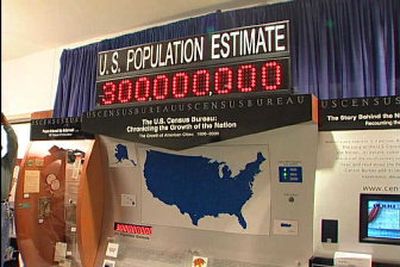U.S. hits 300 million without a lot of fuss

WASHINGTON – Maybe there will be a bigger party when the population hits 400 million. Save the date: 2043.
America’s official population passed the 300 million mark Tuesday, fueled by a growing number of immigrants and their children.
The moment, recorded at 4:46 a.m. PDT, passed with little fanfare, perhaps dampened by a divisive debate over illegal immigration and the fact that many experts think the population had already hit the 300 million mark months ago.
There were no fireworks or government-sponsored celebrations. Just a written statement from President Bush near the end of the work day, welcoming the milestone as “further proof that the American Dream remains as bright and hopeful as ever.”
“It’s a couple of weeks before an election when illegal immigration is a high-profile issue, and they don’t want to make a big deal out of it,” said William Frey, a demographer at the Brookings Institution, a Washington think tank.
It’s been 39 years since the U.S. population reached 200 million. Since then, about 55 percent of the growth has come from immigrants, their children and their grandchildren, according to a recent report by the Pew Hispanic Center, a nonpartisan research organization.
In other words, if the U.S. had cut off all immigration since 1967, the population would be about 245 million – and a lot less diverse, said Jeffrey Passel, a senior demographer at the center.
“We’ve had much more Asian and Latino immigration than white and black,” said Passel, the study’s author. “That has led to the racial and ethnic diversity that we have today.”
When the population hit 200 million in 1967, more than 80 percent of Americans were white and less than 5 percent were Hispanic. Less than 1 percent were Asian.
Today, Hispanics make up nearly 15 percent of the population and Asians about 5 percent. White non-Hispanics account for about 67 percent, and blacks a little more than 13 percent.
By 2043, white non-Hispanics are expected to be a little more than half. That’s the year the population is projected to hit 400 million, though the numbers could change significantly depending on immigration and birth rates.
The U.S. Census Bureau counts the population every 10 years. In between, it uses administrative records and surveys to estimate monthly averages for births, deaths and net immigration. The bureau has a “population clock” that estimates a birth every seven seconds, a death every 13 seconds and a new immigrant every 31 seconds. Add it together and you get one new American every 11 seconds.